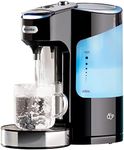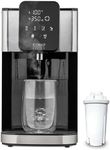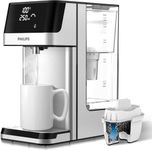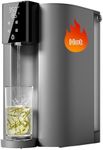Buying Guide for the Best Water Dispensers
Choosing the right water dispenser involves understanding your needs and the features that different models offer. Water dispensers can provide hot, cold, or room temperature water, and they come in various designs and sizes to fit different spaces and uses. Consider where you will place the dispenser, how much water you need it to dispense, and any additional features that might be beneficial for your lifestyle. By focusing on the key specifications, you can find a water dispenser that meets your requirements and enhances your daily hydration routine.Type of DispenserWater dispensers come in several types, including top-loading, bottom-loading, and countertop models. The type of dispenser is important because it affects how you load water and where you can place the unit. Top-loading dispensers require lifting heavy water bottles, which might not be suitable for everyone, but they are often more affordable. Bottom-loading dispensers hide the water bottle inside a cabinet, making them easier to load and more aesthetically pleasing. Countertop models are compact and ideal for small spaces but may have limited capacity. Choose a type based on your physical capabilities, space availability, and aesthetic preferences.
Temperature OptionsWater dispensers can offer hot, cold, and room temperature water. This specification is crucial because it determines the versatility of the dispenser in meeting your hydration needs. Some dispensers provide all three options, while others may only offer hot and cold. If you enjoy tea or instant coffee, a hot water option is beneficial. For refreshing drinks, cold water is essential. Consider your daily water consumption habits and choose a dispenser that provides the temperature options you will use most frequently.
CapacityThe capacity of a water dispenser refers to the size of the water bottle it can accommodate or the amount of water it can store. This is important because it affects how often you need to refill or replace the water. Dispensers typically accommodate standard 3-gallon or 5-gallon bottles. If you have a large family or use a lot of water, a dispenser that supports larger bottles or has a higher storage capacity will be more convenient. For smaller households or less frequent use, a smaller capacity may suffice.
Filtration SystemSome water dispensers come with built-in filtration systems, which can improve the taste and quality of the water. This specification is important if you are concerned about water purity or if your tap water has an unpleasant taste. Filtration systems can vary in complexity, from basic carbon filters to more advanced multi-stage filters. If water quality is a priority for you, look for a dispenser with a reliable filtration system. Consider the cost and availability of replacement filters as part of your decision.
Energy EfficiencyEnergy efficiency in water dispensers refers to how much electricity the unit uses to heat or cool water. This is important for both environmental reasons and to keep your electricity bills in check. Energy-efficient models often have features like energy-saving modes or timers. If you are conscious about energy consumption, look for dispensers with an Energy Star rating or similar certifications. Consider how often you will use the dispenser and whether energy-saving features will make a significant difference in your usage.
Design and SizeThe design and size of a water dispenser are important for ensuring it fits well in your space and matches your decor. Dispensers come in various styles, from sleek and modern to more traditional looks. The size will determine where you can place the dispenser, so measure your available space before choosing a model. If aesthetics are important to you, consider the color and finish of the dispenser. Choose a design that complements your home or office environment and fits comfortably in the designated area.
















